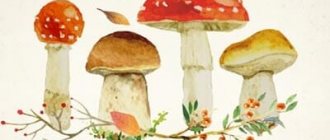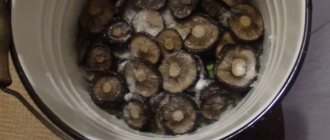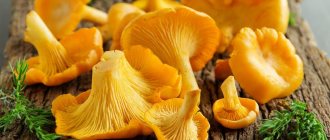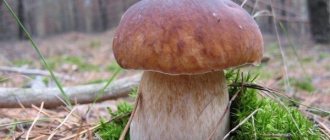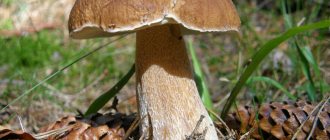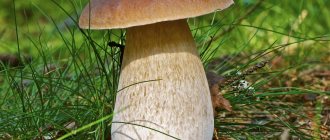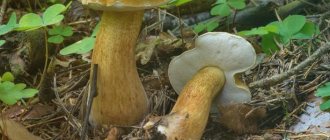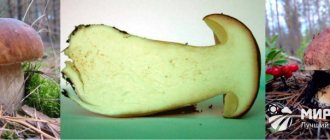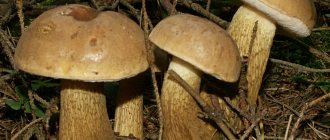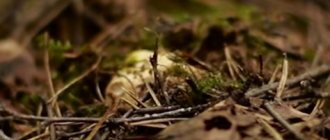Mushrooms
2
1582
Article rating
Kira Stoletova
“Mushroom king” is what people call the porcini mushroom (boletus). It differs from its counterparts in its excellent taste and beneficial properties. Porcini mushrooms have many varieties, which are quite widespread throughout Russia; they are used not only in cooking, but also in medicine. They are in great demand among mushroom pickers, so there is a way to grow it even at home.
Description of white mushroom
Description of the mushroom
The porcini mushroom is often called simply “white” or, in other words, “boletus”.
The peculiarity of this type of mushroom is that even when dried, it retains its natural color of the pulp. Another distinctive feature is the unique, characteristic aroma.
The cap of the white mushroom below has a spongy structure, milky color. Interesting fact: the shape of the cap can be used to judge the age of the fruiting body. In young people the structure is clear and round, but in adults it is flatter.
Benefits of porcini mushrooms: composition, properties
Porcini mushrooms are classified in category I not for their fleshy fruiting bodies or beautiful caps, but for their high nutritional value, excellent taste and abundance of vitamins and minerals.
Plus, porcini mushrooms do not lose their value when dried, and dried mushrooms are better absorbed by the body after cooking. Table: Nutritional value of porcini mushrooms per 100 grams of product
| Index | Quantity |
| Calorie content | 342.4 kJ (81.8 kcal) |
| Fat | 1.70 g |
| Protein | 7.39 g |
| Vitamins | Quantity* |
| Thiamine (B1) | 9%, 0.105 mg |
| Riboflavin (B2) | 8%, 0.092 mg |
| Niacin (B3) | 40%, 6.07 mg |
| Pantothenic acid (B5) | 53%, 2.64 mg |
| Vitamin B6 | 4%, 0.051 mg |
| Folic acid (B9) | 73%, 290 mcg |
| Vitamin C | 5%, 4.21 mg |
| Minerals | Quantity* |
| Calcium | 0%, 1.195 mg |
| Copper | 39%, 0.786 mg |
| Iron | 6%, 0.739 mg |
| Phosphorus | 3%, 22.26 mg |
| Potassium | 4%, 203.3 mg |
| Zinc | 44%, 4.172 mg |
| Units: µg = micrograms, mg = milligrams, IU = international units *Indicated as a percentage of the daily value of an adult |
Despite the high water content in porcini mushrooms (about 90%), porcini mushrooms contain enough vitamins and mineral salts for the prevention and treatment of diseases of the thyroid gland, cardiovascular and digestive systems, as well as for the prevention of intestinal cancer. In addition, porcini mushrooms promote accelerated wound healing and are useful for anemia and long-term inflammatory processes.
Porcini mushrooms promote weight loss. The fact is that they contain a large amount of fiber, which is difficult to digest by the body (digestibility up to 80%). Therefore, eating porcini mushrooms helps people lose weight, despite their high calorie content.
On the other hand, porcini mushroom can cause harm to the health of people suffering from kidney and liver diseases - eating boletus mushrooms significantly increases the load on these organs, therefore.
By the way, freshly picked boletus mushrooms are cooked until tender in 40 minutes. Before cooking, dried mushrooms are soaked in cold water for 2-3 hours, and then boiled until the mushrooms settle to the bottom. Frozen porcini mushrooms are cooked for 30-40 minutes after boiling water in a saucepan.
Porcini mushrooms contain a significant amount of selenium, which helps prevent and treat cancer. Of course, Brazil nuts are much better suited for these purposes, and they also contain more selenium, but porcini mushrooms are closer to us than overseas products.
B vitamins contained in porcini mushrooms help improve the digestive system, which is also beneficial in the prevention of colon cancer.
Appearance
Description of white mushroom:
- Pulp: fleshy, white and juicy in young specimens, but yellowish in mature ones.
- Hat: velvety, dark brown (30-35 cm in diameter). There have been cases when mushroom pickers managed to find rare specimens in an oak grove in which it grew to 50-60 cm.
- Hymenophore: tubular or spongy, with a deep notch at the stem, easily separated from the lower part of the cap.
- Leg: usually quite high (10-12 cm), color ranges from grayish-white to dark brown. Sometimes you come across real forest giants that reach a height of 25-30 cm and look impressive. Depending on age, the shape of the leg also changes. In young specimens it looks like a barrel, while the old mushroom gradually decreases in size and its base dries out.
Interesting facts about porcini mushroom
Boletus is considered one of the largest species; in a relatively short biological cycle it grows to impressive sizes. Specimens weighing more than 3 kg with a diameter of the upper part of about half a meter were found. What is most interesting is that the fruiting bodies were in good condition, not overripe and not spoiled by insects and snails. Taking into account that the porcini mushroom develops in just over a week and grows to such a size, it can safely be called a leader in the speed of vegetation. For comparison, other species grow within 5 days and are several times smaller than boletus mushrooms.
This is the only species that adapts to any environmental situation. In the radioactive Chernobyl zone, porcini mushrooms did not disappear, but grew safely and did not even mutate. At the same time, it is quite difficult to obtain a boletus harvest outside their natural habitat, so the valuable product is not grown for commercial purposes.
Porcini mushrooms are considered originally Russian. There are numerous recipes for cooking with them.
Where do they grow?
Porcini mushrooms grow in different places: found in the forests of Russia, Mexico and the African tropics.
The development cycle directly depends on weather conditions. In temperate climates, the fruiting bodies ripen in late May-early June. Autumn is considered the mushroom season, because until the end of November you can harvest a generous and tasty harvest.
According to the description, they live in colonies, i.e. Several dozen specimens appear on one piece of land. Particularly active during the season of good rain.
Habitats of porcini mushrooms: they grow under pine, birch, oak, in open and sunny clearings or meadows. Loves soil overgrown with moss.
If you are going on a “quiet hunt” for the first time, contact experienced mushroom pickers who will tell you where you can harvest.
Collection rules and deadlines
Even a beginner can collect porcini mushrooms, because they are hard to miss in the forest and easy to distinguish from poisonous representatives of this family, because the difference between them is obvious (Figure 5).
And yet, it would be useful to repeat once again the well-known rules of quiet hunting, so that it brings only pleasure and does not harm your health:
- Do not collect mushrooms that are not absolutely certain of their edibility.
- Avoid busy highways and railways, as well as military and industrial facilities, since it is in such places that the pulp absorbs harmful substances.
- It is better to cut the mushrooms rather than pull them out in order to preserve the mycelium.
- Remember that mushrooms often grow in whole families, since the mycelium stretches along the natural folds of the terrain: ditches, ravines, ruts.
- Leave wormy specimens in the forest by pinning them on a tree branch with the cap down. This way you contribute to the spread of spores, which means the formation of new mycelium. In addition, a dried specimen will be an excellent treat for birds or squirrels.
As for the timing of collection, it should be noted that mycelium growth begins in early spring and ends in late autumn. Accordingly, the collection season is the period lasting from June to mid-September.
Figure 5. The harvest season begins in mid-summer and lasts until autumn
The most favorable for collecting are warm, rainy days, when boletus mushrooms appear en masse on small sunny lawns, edges and forest paths. But in dry summers you should not hope for a large harvest, since mushrooms are very sensitive to humidity levels.
After arriving home, the prey must be immediately processed, for example, dried or prepared as pickled preparations for the winter.
Types of boletus
All types of white mushrooms can be eaten
Edible varieties of porcini mushroom have the following classification:
- B. dark bronze: this species can be distinguished by the color of the cap. The copper or bronze boletus is characterized by a brown cap color. Usually the body comes in all sizes. There are both small and large individuals. Inside, the flesh of the mushroom is white. You can be convinced of this by seeing the handsome man in cross-section. Boletus has a pleasant taste, which persists even after heat treatment of the product. They are easy to find in the fall in mixed and coniferous forests (pine forests), under green pine or spruce.
- B. reticulate: this species is similar in appearance to the moss fly. It has the same leg, shaped like a cylinder, and a large cap (from 10 to 35 cm). It is popular due to its taste. The probability of encountering a reticulated porcini mushroom is high not only in Russia, but also in European countries, as well as the USA. Many boletus mushrooms appear in forest clearings at the end of May.
- B. birch: the name comes from the usual habitat for this species - birch groves. The hat is yellowish-brown in color, not convex in shape. The stem is brown, from 9 to 12 cm. The spores of the fungus are small. This species differs from its fellows - it does not darken in cross section and does not acquire a black color. Leg with pink edging. Mushroom thickets appear several times a year. It is better to look for them in the autumn. They grow in soil that is rich in microelements.
- B. pine: large cap up to 15 cm in diameter, distinguished by a purple color, tasty fleshy pulp, squat leg. Don’t be surprised if you hear the phrase: “The white pine mushroom became embarrassed and turned completely pink.” When cut, boletus mushrooms are distinguished by their burgundy color. Their homeland is pine forests; it is impossible to find these representatives of the Mushroom kingdom on the meadow plain. In order for them to sprout and produce a harvest, rainy weather is necessary. The best time for active growth is spring.
- B. royal: the largest of all varieties of porcini mushrooms. The habitats of this beauty are pine and deciduous forests. Its dimensions: cap - from 20 to 35 cm in diameter, stem height - 10-15 cm. Unusual color - crimson-violet. The pulp is juicy and elastic, gradually changing its color to pink. For a species like this to grow in the soil, it requires heavy rainfall.
- B. oak: This species has become a favorite due to its nutritional value. White oak mushroom does not have a characteristic odor. It is in demand because of its size (12-20 cm), velvety cap of brown color with a grayish tint and large stem. Usually the top of the cap is covered with a film - a skin that becomes sticky in humid weather. The skin grows tightly with the surface of the cap and is almost impossible to remove. The pulp is looser, the taste is sweetish.
- B. spruce: the edible cap is distinguished by its dark burgundy or chestnut color. The top layer of the cap is rough. The leg is smooth, massive, elongated, covered with a light mesh on top. The white spruce mushroom feels great on the ground, which is covered with dry needles.
- B. yellow: The mushroom cap is golden-white in color. Its shape is convex, reminiscent of a pillow. The surface is smooth. In damp weather, it is covered with a mesh mucous coating. The first layer is elastic, but over time, deep cracks begin to cover the mushroom. Boletus grows on a thick stalk that does not have a mesh. The surface of the leg may be covered with small scales. The cut area quickly turns blue. The composition of this product includes a lot of microelements beneficial for human health. The king of the forest has a memorable taste.
The types of porcini mushrooms are very diverse and are allowed to be eaten. Boletuses are mycorrhiza-formers. They usually enter into symbiosis with various deciduous and coniferous woody plants.
Irina Selyutina (Biologist):
Thanks to folk attentiveness, a connection was noted between the appearance of porcini and other types of mushrooms: the boron form of the porcini mushroom appears in the fall almost simultaneously with the greenfinch, in oak forests with green russula, and in birch forests with chanterelle.
For his development he prefers:
- well-drained soils, but without waterlogging (sandy, sandy loam, loamy). Avoids peat and swamp soils;
- trees over 50 years old, forests with formed moss and lichen cover. However, at the same time, in pine forests the maximum yields of this fungus can be collected if the trees are 20-25 years old.
The optimal temperature for the development of fruiting bodies is +15...+18°C in July and August, as well as +8...+10°C in September. But large differences in day and night temperatures and large amounts of precipitation lead to a reduction or complete cessation of fungal development. The white mushroom appears in masses after short thunderstorms and foggy warm nights.
In the process of evolution, the porcini mushroom populated almost all the continents of the Northern Hemisphere. It was brought to the continents of the southern hemisphere with seedlings of mycorrhizal coniferous trees.
Despite its wide distribution, the porcini mushroom is still absent in some places in the wild. And then “white” are called in those areas mushrooms that have a really white or very light color of the fruiting body, but are not real boletus mushrooms. Examples of such “doubles” can be white boletus, giant talker mushroom, steppe oyster mushroom (steppe porcini mushroom).
How to distinguish a white mushroom from a false one?
In nature, there is such a thing as a “false porcini mushroom.” This is a separate species of lower plants that can easily be confused with potential prey. The false white mushroom is popularly called bitter. There are several main differences that allow you to determine the variety of representatives of the mushroom kingdom:
- Cut color - to determine which mushroom you have collected, you need to cut it. The pulp of a genuine mushroom always remains white, while the inner layer of the fruiting body of bitterling will darken and acquire a pinkish-brown tint.
- Stem structure - the gall mushroom has a very interesting stalk structure - it has a peculiar pattern that resembles a mesh (the boletus mushroom does not have this).
- Hymenophore - in the false porcini mushroom the tubular layer has a pinkish tint, in the edible genuine plant it is yellowish or white.
- The taste of bittersweet can be easily identified by tasting a dish prepared from it. The false mushroom has a bitter, unpleasant taste, which does not change when cooked or fried. White boletus has a pleasant aroma and spicy taste.
False mushroom in section
Gorchak - an inedible double of the porcini mushroom
In order not to make a mistake and not to serve a tasteless dish, novice mushroom pickers should carefully familiarize themselves with the main differences between porcini mushrooms and mustard mushrooms.
Beneficial features
They say about the porcini mushroom that it is a storehouse of nutrients. The product contains trace elements that are necessary for humans to overcome many diseases.
Beneficial features:
- Contains selenium. It prevents “activated cancer” cells from multiplying.
- The chemical composition includes vitamin C. The properties of ascorbic acid make it possible to maintain the vitality of the human body. Appetite improves, the immune system is restored, and insomnia disappears.
- All types of porcini mushrooms contain vital material for our bones - calcium. By including this product in your diet, you will compensate for the lack of the following microelements - iron, potassium, and B vitamins, which will help improve memory, restore the functioning of the nervous system, and restore blood circulation in the brain.
- Helps cleanse the blood.
- Vitamin A is essential for maintaining beautiful and healthy skin.
- Eating porcini mushrooms will help regulate the functioning of the thyroid gland.
for children and parents
In the kingdom of mushrooms, as in any other kingdom, there must be a king.
The porcini mushroom, also known as boletus, is rightfully considered such a ruler of mushrooms. Among other mushrooms, it stands out noticeably both in size and in its nutritional properties and taste. Porcini mushrooms can be found in almost any forest on our planet, but for some reason they do not grow in Australia. You can find a porcini mushroom in any forest, near any tree, but most of all they prefer proximity to spruce and pine trees, as well as birch or oak. The collection of porcini mushrooms begins in June and continues until October. The porcini mushroom justifies its title as king of mushrooms by its size. Its cap can have a diameter from seven to thirty centimeters, and the leg reaches a height of more than twenty centimeters. The color of the mushroom cap can vary depending on the surrounding conditions - reddish-brown or lemon yellow, orange or purple.
The leg of the porcini mushroom is strong, substantial and has the shape of a barrel. The color of the stem may be the same as that of the cap, but of a lighter shade. The entire leg of the porcini mushroom is covered with a network of light veins.
The flesh of the mushroom is strong, juicy and meaty. If you cut a mushroom, the cut will remain white and will not darken over time, which is why the mushroom got its name. There are different opinions about another name for this mushroom - boletus. According to one version, the name “boletus” appeared because these mushrooms grow in pine forests. Another version has a mythical, fairy-tale character. In Rus', boletus was the name given to forest spirits who could take the form of mushrooms and lure people into the forest thicket. The white mushroom, with its large size, could perfectly accommodate the spirit of the forest, the boletus, and over time, the second name for the white mushroom became familiar and ubiquitous.
Porcini mushroom dishes are prepared in different ways. They can be boiled and fried, salted and pickled. Porcini mushrooms make a delicious sauce. And in Italy they are consumed raw in various salads.
Beneficial properties of porcini mushrooms (boletus mushrooms)
Porcini mushrooms have a lot of protein, twice as much as in meat and three times as much as in fish. They also contain a lot of microelements and amino acids. Porcini mushrooms stimulate digestion well and increase appetite. There is also an opinion that porcini mushrooms have the property of preventing malignant formations.
Text author: Lev Poyasnikin
This entry is password protected. Enter your password to view comments.
The name porcini mushroom is due to the fact that the tubular spore-bearing layer of young mushrooms is always white.
Damage to boletus
Boletus is not suitable for feeding children
The energy value of porcini mushroom is high, but at the same time you should be careful. It is strictly contraindicated during pregnancy and for feeding children.
Negative characteristic:
- The life cycle of the porcini mushroom is extremely short, so it is easy to get poisoned by it (the overripe fruiting body).
- They are difficult to digest, which sometimes causes digestive system upset.
- The chitin content negatively affects kidney function.
- Absorbs harmful substances from the environment.
- The “kings” of the forest are strong allergens, so they should be consumed with great caution.
- There are poisonous counterparts, in particular the gall fungus. These mushrooms can be easily distinguished by the color of the hymenophore. The gall boletus has a red inner cap, and it also has a looser pulp structure.
The value of porcini mushroom is unique, but when consuming this product, be careful, focusing on your health, because if not processed correctly, it releases harmful substances.
Popular message topics
- The influence of bad habits on human development
It is possible that every person has bad habits that have a bad effect on the internal and mental state of a person. Many bad habits have become part of the usual way of life and carry with them a lot of deplorable and unpleasant consequences. - Ancient India
Ancient India is a country that lived 2600-1900 BC. It was at this time that she reached her greatest dawn in development. India was located in Asia. It occupied a very large territory, - Creativity of Mamin-Sibiryak
Dmitry Narkisovich Mamin-Sibiryak was born in the Urals, in the village of Visim, which is now located in the Sverdlovsk region, in 1852. The father of the future writer was a priest. The boy is studying at home
Mode of application
BZHU - 35 kcal per 100 g. The calorie content of porcini mushrooms depends on the method of preparation. It is prepared fried, boiled, stewed and dried, and pickled for the winter. In medicine, infusions and decoctions based on mushroom broth are used.
In cooking
Porcini mushrooms have a pleasant taste, which is why they are highly valued in cooking. Their usefulness is due to the unique fats and carbohydrates in their composition - they are necessary to maintain normal well-being.
Only fresh ones are suitable for cooking; if stored raw for some time, you can be poisoned.
The largest amount of useful microelements enters the human body in dried form (75-80%).
Before cooking, you should check the edibility of the boletus mushroom. This is easy to do: when cooking, add onion to boiling water. If it turns blue, it is better not to use the product, because... it contains bitter toxic substances.
It is used to prepare light soups (broth based on it is considered as healthy as chicken broth), appetizers, salads, toppings for baked goods, main courses, and sauces. Among other products, boletus mushrooms differ in that they do not take long to prepare. They need to be boiled for 5-7 minutes.
This product must be soaked before cooking. Store prepared meals in a cool place, preferably in the refrigerator.
In medicine
Porcini mushrooms grow in the forests and are used by traditional healers. Alcohol tincture, decoction, fresh juice or powder are considered traditional medicine.
- treat diseases of the cardiac and venous systems;
- strengthen the body's defenses;
- serve as a prevention of pulmonary tuberculosis;
- kill parasites;
- improve the condition of the genitourinary system.
Eating porcini mushroom stimulates cell renewal. The contents of the product allow the human body to independently cope with many diseases: cardiovascular, physical and mental fatigue, prevention of influenza, stroke, cancer, increased immunity, normalization of metabolism.
To prepare a medicinal product, fill a liter jar with well-washed, dried and cut boletus caps and add high-quality vodka to cover the product. The tincture is prepared for 15 days in a dark, warm place. After this, it is filtered, the raw material is squeezed out and poured into a container that will be stored in the refrigerator. Take 2 times a day 30 minutes before meals, 1 tsp. with a small amount of cold boiled water. This preparation is saved for the winter; it tastes bitter. The course is usually 1-3 months, depending on the disease. If you want to improve your well-being with varicose veins or thrombophlebitis, then in parallel with taking the tincture orally, rub it into problem areas of the lower extremities.
Pregnant women should not be treated in this way. The medicine is dangerous for the health of the unborn baby; the risk group also includes people with severe pathologies and individual intolerance to the components.
Attention! Before taking the tincture, you should consult your doctor.
Facts about porcini mushrooms
- Porcini mushrooms stimulate the secretion of digestive juices better than meat broths. Mushroom broth is 7 times more nutritious than meat broth.
- Porcini mushrooms being natural “sponges”, they absorb heavy metals: radioactive cesium, strontium, cadmium, mercury and lead. Therefore, you should not pick mushrooms near industrial cities and busy highways.
- Porcini mushrooms should not be eaten by young children. Children lack the digestive enzyme that helps digest mushrooms.
- Drying is the best way to store porcini mushrooms.
- Adding a small amount of porcini mushrooms significantly enhances the taste and aroma of meat, game, fish, sauces and appetizers. Porcini mushrooms are especially recommended as an additive to potatoes and flour products.
- In Switzerland, boletus mushrooms are considered inedible mushrooms.
- In 1961, the radio reported the discovery of a porcini mushroom with a cap diameter of 58 cm and weighing over 10 kg.
- In 2002, a robot discovered mushrooms in the destroyed reactor of the Chernobyl nuclear power plant. Not only did they not die, but they also reproduced beautifully.
- The porcini mushroom is one of the most “ubiquitous” mushrooms; it grows from the borders of the tundra to the borders of the subtropics.
- The color of the porcini mushroom depends not only on the place where it grows, but also on what kind of forest surrounds it - coniferous or deciduous.
- Raisins at home: how to make
- Tulsi (holy basil): beneficial properties
Growing methods
Mushrooms can be grown in the garden
It is not difficult to organize the cultivation of porcini mushrooms on a personal plot. The easiest way is to grow them in the garden with your own hands. The plant reproduces in two main ways.
From mycelium
To create a mushroom bed at home in your garden plot, you need to grow “seeds”. Buy mycelium (spores) from a specialty store. Such seedlings are not uncommon, because many people want to have homemade boletus.
Prepare the soil in advance, immediately after the snow melts. The best place is the ground around the trees. Oak, green pine and birch are suitable, i.e. symbiont trees. Clear 1.5-2 m of all plants around them - this is where the planting site will be.
Fertilize the soil before planting the spores. Use organic matter - peat, compost. Then try to evenly seed the soil with mycelium. Don't forget to water it well. Wait for mushroom threads to appear on thin stalks, and insulate the mycelium in the winter with straw.
Growing porcini mushrooms in your summer cottage in this way is not difficult. The harvest can be harvested the following spring. Usually one mycelium bears fruit for no more than 4-5 years.
From hats
To plant porcini mushrooms in a similar way, prepare boletus caps: separate them from the stem and place them in the sun to ripen. The size of the caps should be at least 5-10 cm in diameter. Please note that boletus mushrooms will need to be planted in the same place where they grew previously. This planting will preserve the best mushroom specimens.
The dried caps are soaked in water for a day, and then rubbed by hand into a homogeneous paste. By squeezing the raw materials using gauze, you will get mushroom spores (in water), which you can use for further breeding of boletus mushrooms. Sow the mycelium, carefully distributing it over the entire surface of the planting site, after which it is regularly watered and checked to ensure that the mycelium does not begin to rot.
Scheme of the structure of a cap mushroom
Everyone knows that a mushroom consists of a stem and a cap, which is what we cut off when we pick mushrooms. However, this is only a small part of the mushroom, called the “fruiting body”. Based on the structure of the fruiting body, you can determine whether a mushroom is edible or not. The fruiting bodies are made up of intertwined threads called “hyphae.” If you turn the mushroom over and look at the cap from below, you will notice that some mushrooms have thin plastics there (these are lamellar mushrooms), while others are like a sponge (sponge mushrooms). It is there that the spores (very small seeds) necessary for the reproduction of the fungus are formed.
The fruiting body makes up only 10% of the mushroom itself. The main part of the fungus is the mycelium; it is not visible to the eye because it is located in the soil or tree bark and is also an interweaving of hyphae. Another name for mycelium is “mycelium”. A large area of the mycelium is necessary for the mushroom to collect nutrients and moisture. In addition, it attaches the fungus to the surface and promotes further spread over it.
Habitats
Boletus likes mature and old forests with an abundance of moss and lichens, but it also feels great on sandy, sandy loam, and loamy soils. The white mushroom is common on all continents except Australia.
Warm, foggy nights and short heavy rains, especially in the second half of August, are ideal weather conditions when whites delight in huge numbers. Boletus is found from June to September.
